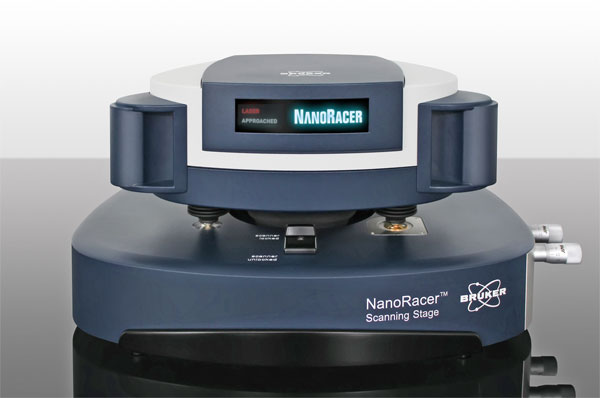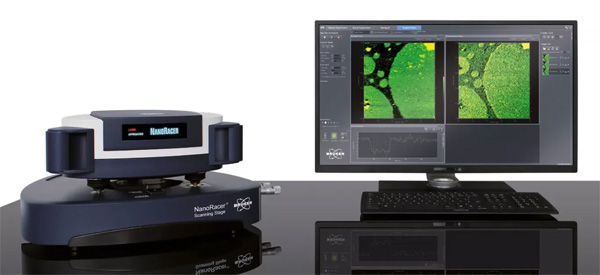NEW NanoRacer
Biological AFM at up to 50 frames per second
The Bruker JPK NanoRacer is a biological AFM (Atomic Force Microscope) with speeds of up to 50 frames per second for studying dynamic biological processes in real time.
The NanoRacer opens a whole range of new possibilities for AFM in life science applications, enabling you to gain an in-depth understanding of complex biological systems and molecular mechanisms.
- Fastest high resolution AFM available – 50 frames/sec
- Intuitive, easy-to-use software
- Newly developed high-speed head and scanner
- Automated cantilever alignment
- Robust concentric design for maximum stability
- Optimised for small and medium-sized cantilevers
- Cutting-edge electronics
- Available with PeakForce Tapping (optional – exclusive to Bruker)
Contact us for more information and quotes:
+44 (0)1223 422 269 or info@blue-scientific.com

DNA Molecule in Fluid
Part of an individual DNA molecule imaged in fluid on mica+PLO substrate in closed-loop. The video consists of 1000 images acquired without user assistance at an imaging speed of 50 frames/sec. This demonstrates the stability and low force imaging of the NanoRacer even at high speeds.
x-range 100 nm (100 pixels), y-range 80 nm (80 pixels), z-range 2.0nm.
DNA Origami
DNA origami nanostructures containing 5 biotin binding sites on mica imaged in fluid with streptavidin presence. It was taken in closed-loop with the Bruker JPK NanoRacer, as an example of high speed and low interaction forces for studying molecular binding phenomena.
The bright dots appearing and disappearing on top of the origamis depict streptavidin molecules binding and unbinding with the origami nanostructures. The video consists of 478 individual AFM scans taken at a rate of 35 frames/sec, with a maximum tip velocity of more than 1.2 mm/s.
x-range is 200 nm (100 pixels), y-range 166 nm (83 pixels), z-range 3.5nm.
Taken in collaboration with C.M. Domínguez and C.M. Niemeyer of the Institute for Biological Interfaces (IBG-1), KIT (Germany).
Streptavidin Binding to Biotinylated DNA Origami at 50 frames/s
High speed AFM imaging of DNA origami nanostructures containing 5 biotin binding sites on mica imaged in buffer with streptavidin presence. Streptavidin binding/unbinding can be observed on top of the DNA origami nanostructures as bright dots appearing and disappearing.
The video is taken at 50 frames/sec. It consists of over 1700 frames, x,y-range 150 nm. Taken in collaboration with C.M. Domínguez, C.M. Niemeyer, Institute for Biological Interfaces (IBG-1), KIT (Germany).
User-Friendly Features
The NanoRacer has been designed with convenient features for the best user experience:
- Easy sample and probe loading.
- Portable sample carrier for preparing samples on the bench.
- Change probes in just a few minutes.
- No calibration thanks to the closed-loop scanner design.
- Navigate easily with an integrated camera for locating areas of interest.
- Fluid exchange via direct injection.
- Newly designed 3-port liquid cell for photothermal excitation.
A great deal of thought has been put into developing these features, to eliminate complicated, time-consuming procedures and make the system easy to use, even for those new to AFM.
Short time-to-data is crucial for achieving dynamic results on active single molecule samples. All components have been designed for convenient handling, from sample preparation to fully motorised, automatic optical alignment. These streamlined procedures give you fast data collection and results.
- Automated cantilever alignment
- Optimised drift compensation
- Automated photothermal laser alignment (optional)
- Internal camera with autofocus
- Automated calibration of cantilever spring constant

High Resolution and Stability
The NanoRacer has the lowest noise levels of any AFM commercially available, with high precision electronics and enhanced accuracy positioning sensors in each axis. Imaging atomic defects and sub-molecular resolution are now routine.
- Small cantilevers and low forces for minimal sample damage.
- Infrared laser photothermal excitation (optional), for clean cantilever driving, easy set-up and to reduce disturbance of delicate samples.
- Advanced algorithms for scanner control and feedback.
- Minimal force drift for long-term experiments.
- Highest bandwidth digital electronics with lowest noise, for maximum performance.
- Cutting-edge, high-speed power amplifier for the best scanner drive performance.
- Closed-loop scanning on all axes with minimal noise levels for high accuracy.
Standard Modes
Imaging modes
- TappingMode™ with PhaseImaging™
- Contact mode with lateral force microscopy (LFM)
Force measurements
- Static and dynamic spectroscopy
- Advanced Force Mapping
Optional Modes
- PeakForce Tapping™ for imaging
- Advanced AC modes eg FM and PM with Q-control and Active Gain Control
- Higher harmonics imaging
- NanoManipulation
- ExperimentPlanner™ for designing a specific measurement workflow
- RampDesigner™ for custom designed clamp and ramp experiments
- ExperimentControl™ feature for remote experiment control

